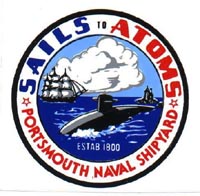|
FRESH STUFF DAILY |
|
|
||
|
|
||
|
|
||
|
SEE ALL SIGNED BOOKS by J. Dennis Robinson click here |
||
Page 2 of 2
SUBS & SHIPS: Most of the warships and all of the submarines touted in Portsmouth history were built at Kittery. That includes the Kearsage, famed for its battle with the Confederate ship Alabama in the Civil War. That includes submarines Thresher, Squalus, Albacore and all the rest. "Portsmouth-built" is just another way of saying "Made in Kittery". OLD IRONSIDES: Among the most famous ships repaired at Kittery Was the USS Constitution or "Old Ironsides" and one of the earliest photos in the Navy archives shows Ironsides under repair there in 1855. It remained as a tourist attraction, visible from Portsmouth, for more than a decade in the late 1800s.Immediately after the war of 1812, the commander of Old Ironsides, Isaac Hull took over as commander of the navy yard. Hull whipped the fledgling yard into shape. FORTS: When we talk about the many forts that successfully warded off all enemies along the Piscataqua for three centuries, we note that half of them are in Maine. But the only reconstructed one, the hexagonal Fort McClary, stands proudly at Kittery Point, although it is named after a New Hampshire soldier. HENDERSON'S POINT: And when we say that the biggest dynamite explosion on earth at thet time took place in Portsmouth Harbor in 1905, the spit of land blown up was Henderson’s Point in Kittery.
VICTORIAN HOTELS: The Treaty delegates stayed at the Wentworth Hotel in New Castle, but in fact, Kittery had more than its share of Victorian tourist hotels -- now all gone. They included Hotel Parkfield (1887), the Pepperell House (1872) The Pocahontas on Gerrish Island (1880s), and the Champernowne (1890). APPLEDORE: The most famous Victorian hotel in the region was on Appledore Island and operated by Thomas and Eliza Laighton and their children, Celia, Oscar and Cedric. Appledore Island, thanks to the Mason and Gorges property division, is technically part of Kittery. CELIA THAXTER: Although poet Celia Thaxter was born in Portsmouth, she and her estranged husband Levi Thaxter owned land at Kittery Point. Levi and all three of their children – Karl, John and Roland – are buried at Kittery Point, between the historic Pepperrell House and the tomb of William Pepperrell. SMUTTYNOSE: Smuttynose Island too Is part of Kittery, so all those stories about the 1873 murders retold in the book Weight of Water, are Kittery stories too. When killer Louis Wagner was apprehended and jailed at Portsmouth the following day, his lawyer pointed out that the heinous acts had been committed in Maine, not New Hampshire. Wagner was then jailed, tried, convicted and hanged in Maine. ELECTRIC TRAINS; By the late 19th century, it was possible to take an electric trolley from Augusta, Maine all the way to New York City. There was only one spot in the entire journey where visitors had to leave the land and travel to another state by ferry. There was still no easy road between this Maine town and its rival city Portsmouth. W D HOWELLS: The region’s tallest literary giant, William Dean Howells, editor of Atlantic Monthly and Harpers, promoted this region to visitors across the nation. He was a summer resident of Kittery Point. STRAWBERY BANKE: And speaking of the Howells family, it was Muriel and John Meade Howells of Kittery who got the ball rolling on the creation of Strawbery Banke Museum prior to 1958. They had to overcome the fact that Portsmouth city officials were not originally interested in saving historic houses, when the requests came from foreigners who lived across the river in Kittery. Rosamund Thaxter of Kittery, Celia’s granddaughter, was among the first major contributors to the new Portsmouth museum. I could go on, but why embarrass the Port City further? Portsmouth needs Kittery like Chang needs Eng. The cities are bound at the river’s edge, as separate and inseparable as Siamese twins that share the same flowing blood. Both cities were born from the same British investment group. New Hampshire got the short stick with 18 coastal miles. Maine boldly lists its coastal perimeter as just under 3,500 miles. It doesn’t take a therapy degree to understand why Portsmouth historians suffer from feelings of inadequacy and may, from time to time, stretch the truth a little. (c) Copyright SeacoastNH.com
Please visit these SeacoastNH.com ad partners.
News about Portsmouth from Fosters.com |
| Thursday, April 25, 2024 |


|
Copyright ® 1996-2020 SeacoastNH.com. All rights reserved. Privacy Statement
Site maintained by ad-cetera graphics

 HISTORY
HISTORY



 NAVY YARD
NAVY YARD TREATY OF PORTSMOUTH
TREATY OF PORTSMOUTH














